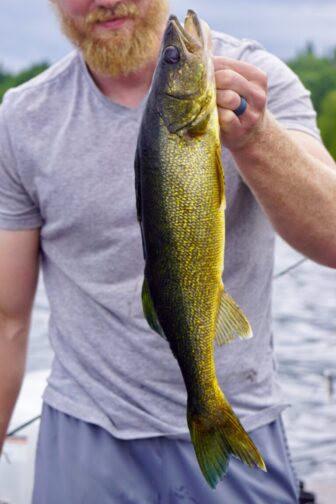By TAYLOR HAELTERMAN
Capital News Service
LANSING — Scientists are simulating Great Lakes walleye on computers to find out how contaminants harm the fish.
The new technique is important because it helps experts more efficiently discover how to clean up contaminants.
These contaminants of emerging concern come from agricultural and household cleaning products and medicines that end up in lakes and rivers, according to the U.S. Geological Survey.
Many are unregulated because of their common use and the lack of understanding of their toxicity and impacts on the ecosystem, said Stephanie Hummel, a fish and wildlife biologist for the U.S. Fish and Wildlife Service and an author of the study. It appeared recently in the journal Science of the Total Environment.
Researchers made a computer model of walleye in Lake Erie and the Maumee River based on lab data to see if contaminants would affect fish reproduction and how to best reduce the level of the chemicals in the water, said coauthor Maxime Vaugeois, who worked on the model.
Information on the fish’s growth, reproduction and life cycle simulated individual walleye. Data on walleye population density, size, migration and reproduction simulated the actual fish, said Vaugeois, a postdoctoral researcher in the University of Minnesota Department of Biology, Evolution and Behavior.

Zab Consulting via Unsplash
Scientists use simulations to protect walleyes.Data on the amount of chemicals along the river determined the level of exposure to the fish. The study focused on agricultural chemicals from herbicides used to kill unwanted plants and on urban chemicals from household products and medications.
The researchers chose the walleye because of its commercial and recreational importance to the Great Lakes region and the Maumee River and because of the amount activity near it that produces contaminants, Vaugeois said.
“The Maumee River is a really important river in the Great Lakes area,” he said. “It’s one of the major watersheds. It’s also a river that’s under stress. There are many agricultural activities, and there’s also urban activity on the river.”
The study compares the impact on walleye population for two clean-up strategies – completely cleaning a specific area or partially cleaning the entire body of water.
Both strategies can be effective. But what strategy will be most effective in a specific situation depends on the location, fish and types of contaminants, Vaugeois said.
Focusing on a single site is most effective where walleye lay their eggs.
But focusing on the entire body of water could be the more effective option, depending on the types of contaminants and information on the walleye population, like mortality rate and how quickly the chemicals are taken up by the fish, Vaugeois said.
Hummel said it’s important to start discussing these management practices soon because previous research shows that contaminants have affected fish reproduction.
A study of fathead minnows found that fish reproduction dropped when exposed to contaminants like those used in the walleye study. That can eventually lead to population decrease.
“We call them sublethal effects,” Hummel said. “We’re not seeing mass die-off and huge plummets in the population, but we are seeing these sublethal effects that can be additive when you’ve got poor habitat availability or food availability, changes in the food web, things like that.”
That’s a stressor that can further impact walleye and reduce their population levels, she said.
Contaminant cleanups are costly and take years to show results. But using simulations is a cheaper and faster way to test possible outcomes, Vaugeois said. The results can help guide fishery management.
“At the end what we all want is to be more efficient about how we protect the environment,” he said. “And this kind of research can help us understand where you need to focus more, where you need to spend most and be more efficient about how you gather information and how you will use it for a cleanup strategy.”
Vaugeois said the next step is more research on how these contaminants affect fish and how fast they’re eliminated by fish.
That will help scientists better understand the best strategy for cleaning the Great Lakes, he said.
Taylor Haelterman writes for Great Lakes Echo.